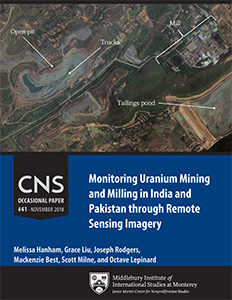November 19, 2018
Melissa Hanham, Grace Liu, Joseph Rodgers, Ben McIntosh, Margaret Rowland, Mackenzie Best, Scott Milne, and Octave Lepinard
New and advancing geospatial technologies hold great potential for aiding analysts. The use of tools such as hyperspectral analysis, change-detection algorithms, and the advancement of machine learning have the potential to reveal a more comprehensive view of the nuclear activities at the front end of the fuel cycle within states of concern.
CNS Occasional Paper #41 details existing and potential uranium mines and mills in India and Pakistan as part of an ongoing project to track uranium production in Asian states that possess nuclear weapons. As non-signatories to the Treaty on the Non-Proliferation of Nuclear Weapons, India and Pakistan face challenges procuring fissile material from foreign sources. Both countries have ongoing nuclear-weapon programs, clear and increasing demands to supply their nuclear-energy programs, and domestic production deficits. The continuing and increasing demand for uranium in India and Pakistan indicates that domestic uranium production is likely to grow significantly in the near future. This paper explores remote-sensing techniques that can allow open-source analysts to monitor and track front-end uranium production activity in these countries.
India and Pakistan both have plans to expand their nuclear-energy industries, increasing both countries’ demands for uranium. However, without membership in the NPT, both countries face a multitude of challenges to importing uranium. They are not entitled to receive nuclear-related technologies from nuclear-weapon states, nor are they allowed to trade nuclear materials with any NPT states parties. This leaves only non-signatory countries as possible trading partners: Israel, North Korea, and South Sudan. Pakistan has a history of trade with North Korea through the now-defunct A.Q. Khan network.
Both India and Pakistan are expanding existing uranium mines and mills and funding exploratory research into new sites for uranium-resource exploitation. Both countries still rely heavily on domestic production of uranium resources, which allows analysts to gain significant insight into their nuclear capabilities by monitoring domestic uranium-production sites. The operational output of a mine or processing plant can be gauged by weighing numerous factors, including the amounts of vehicle traffic, construction on the site, tailings and waste piles, and changes in the surrounding environment.

